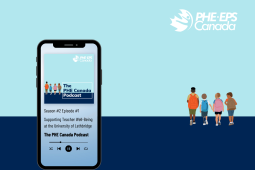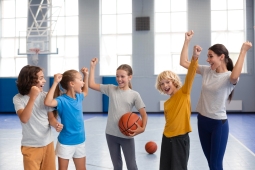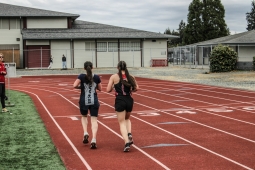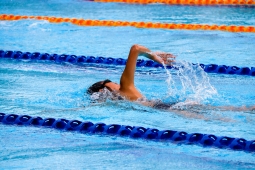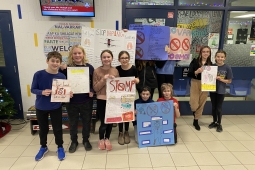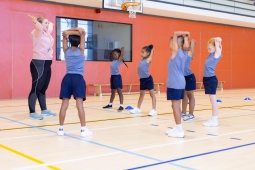Instant Activities: Winter Series

These activities are from the PHE Learning Centre’s Physical Education Activities. These K-12 activities require minimal equipment and include learning outcomes such as fundamental movement skills, teamwork, problem-solving, and safety concepts. They have been designed to support children and youth in developing, acquiring, and learning the 4 Physical Education Competencies and they follow the STEP framework for inclusion considerations:
Get ready for your featured winter instant activities!
K- Grade 3: Mush Rush
Equipment: Snow
Learning Outcome: Demonstrate locomotor skills, how to follow instructions, and how to respect the space of others.
Activity Description:
Review movement skill cues for running, skipping, jumping, and hopping with your students as they will be asked to perform these in the snow.
Explain that dog sledding is a form of transportation to help people travel across the snow. Dogs wear a harness and are usually lined up in twos attached by a rope to a sled. Each pair of dogs have a role to help the sled travel as fast and safely as possible. Explain that the command of “Mush” is often used by the person driving the sled to make the dogs go or move faster. Dogs can act as:
● Leader(s): 1-2 dogs that guide the team
● Point dogs: Provide encouragement and are training to be leaders
● Wheel dogs: Strongest dogs that keep the sled on its track
● Swing dogs: Maintain team organization while rounding corners
Set-Up:
● Students stand in a large circle.
● Assign each student a role randomly – Leader, Point dog, Wheel dog, or Swing dog. Only 1-2 student(s) will be appointed the Leader.
How to Play:
● Students march on the spot throughout the activity.
● Leader(s) calls 1 of the 3 roles: point dogs, wheel dogs, or swing dogs.
● Leader(s) also call out how students move from one spot in the circle to another (i.e., running, skipping, jumping, hopping, crab walking, galloping, etc.).
● The students can move clockwise, counterclockwise or through the circle and take the next vacant place. The teacher or the leader can determine this.
● Alternate Leaders and other dog roles throughout the activity.
● Add different challenges:
○ Leader(s) calls out “Mush!”, then picks a role and movement (i.e., “Mush, point dogs, hop (to the vacant spot)!”). Point dogs run as fast as they can to a spot in the outer perimeter of the playing area, touch it, run back to their spot and then hop around the circle to take the next vacant place in the circle.
○ Leader(s) can call multiple roles at once.
At the end, consider asking students the following reflection questions and have students answer them based on your preference – i.e., discuss together or in small groups, write them in a reflection journal, or any other strategy of your choosing:
● What did you enjoy most about this activity?
● Which mode of transport was the most challenging to perform? Why?
Grade 4-6: Modified Inuit Blanket Toss
Equipment: 5-10 balls, 3 blankets/sheets/parachutes
Learning Outcome: Participate in an Inuit game and demonstrate teamwork and problem-solving skills.
Activity Description:
Introduce the Inuit Blanket Toss to students and consider sharing this video:
Explain that Inuit festivals and other celebrations have often involved blanket toss games where players are thrown or bounced up into the air using a blanket made of seal or walrus skin. Several rounds were played and the player who bounced the highest was the winner. The blanket toss was created for hunters who would be bounced in the air to see animals that could be hunted in the distance.
Set-Up:
● Divide students into three groups.
● Provide each group with a blanket, sheet, or parachute and one ball.
How to Play:
● Group members spread out around the blanket/sheet, each holding onto a section.
● One group member places the ball onto the blanket and groups decide how they will know when to toss the ball (e.g., one group member calling it, all counting, etc.).
● Groups practice tossing the ball on the blanket to see how high they can toss the ball. Try different variations of the toss (i.e., multiple balls on the blanket and toss them to group members acting as catchers).
● Groups can work together to pass a ball back and forth. Encourage students to come up with other variations of the game and play them as well.
At the end, consider asking students the following reflection questions and have students answer them based on your preference – i.e., discuss together or in small groups, write them in a reflection journal, or any other strategy of your choosing:
● How did your tossing technique change from the beginning of the activity to the end of the activity?
● What did your group do to be successful at tossing the ball(s)?
Grade 7-12: Winter Walk, Talk and Thought
Equipment: Snow, hiking poles (optional)
Learning Outcome: Demonstrate concepts and strategies to participate safely and knowledgeably in outdoor physical activities during the winter.
Activity Description:
Take your class outside for a winter hike around the school yard, along a local community trail, or on the sidewalk in your school community. Before you go, have your students review the following articles either as a whole class, small group, partners, or individually:
On the walk, students will be present and observe their surroundings, paying close attention to “what they hear, see, smell, feel, and touch”. Take moments to pause and ask students the following questions. Encourage students to share or reflect on what they have learned from the readings and/or their personal opinions on the subject matter:
● How can people be physically active outside during the winter months?
● What does one need to consider before engaging in physical activity outside during the winter?
● What are some of the health benefits of spending time outdoors during the winter?
● How can spending time outdoors in the winter support mental well-being?
● What are the risks associated with spending too much time outside in extremely cold weather?
● What are some of the signs and symptoms of frostbite and/or hypothermia to look out for when being physically active outside during the winter?
● Historically in Canada, how have groups survived the cold climate in the winter?
At the end, consider asking students the following reflection questions and have students answer them based on your preference – i.e., discuss together or in small groups, write them in a reflection journal, or any other strategy of your choosing:
● In what ways were you present during the hike?
● What is one goal you can set for yourself to be physically active outside this winter (use the SMART strategy: set a goal that is specific, measurable, attainable, relevant, and timely)?



